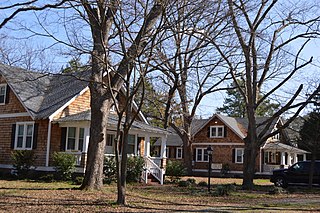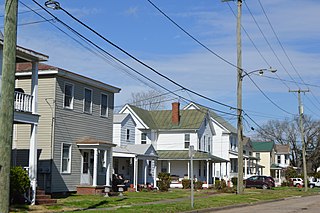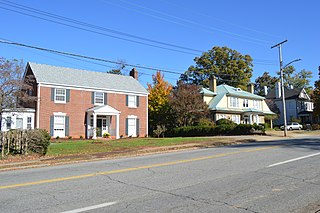
Colonial Place is a residential neighborhood in Norfolk, Virginia. It is a peninsula bordered by 38th Street on the south, and surrounded on three sides by the Lafayette River. It is a relatively racially mixed area that includes mostly single family homes and a few apartment buildings. Many large homes front the water and Mayflower Road arches around the shore of the river.

Park Place is a neighborhood in the western half of Norfolk, Virginia. Its boundaries are roughly Granby Street on the east, Colley Avenue on the west, 23rd Street on the south and up to 38th Street to the north. Within these boundaries Park Place is made up of 4 historic subdivisions; Virginia Place, East Kensington, Park Place, and East Old Dominion Place.

Farmville Historic District is a national historic district located at Farmville, Prince Edward County, Virginia. It encompasses 246 contributing buildings and 1 contributing object in the central business district and surrounding residential areas of Farmville. It includes a variety of commercial, residential, institutional, and industrial buildings dating from the mid-19th to early-20th centuries. Notable buildings include the Paulett-Gill house, Farmville Presbyterian Church, Johns Memorial Episcopal Church (1881), Farmville Methodist Church (1907), Hotel Weyanoke (1925), the warehouses of the Dunnington Tobacco Company and Central Virginia Processing, Inc., the former Craddock-Terry Shoe Company, the former Cunningham and Company tobacco prizery, Norfolk and Western Railroad passenger station, Doyne Building, the Watkins M. Abbitt Federal Building (1917), Prince Edward County Courthouse, and the former Farmville High School (1913). Located in the district is the separately listed First Baptist Church.

Bedford Historic District is a national historic district located at Bedford, Virginia. The district encompasses 208 contributing buildings in two residential neighborhoods of Bedford, known locally as the Old Avenel area and the Longwood Avenue area.

Town of Halifax Court House Historic District is a national historic district located at Halifax, Halifax County, Virginia. The district includes 172 contributing buildings, 1 contributing site, 13 contributing structures, and 1 contributing object in the Town of Halifax. Resources include government, commercial, residential, religious, educational and industrial buildings that date from the early-19th Century to the mid-20th century. Notable buildings include the Rice House, Edmunds/Lewis Office (1869), People's Bank, Beth Car Baptist Church (1892), Christ Episcopal Church, Saint Luke's Christian Methodist Episcopal Church, Dr. Carter House, County Office Building (1915), Town of Halifax Swimming Pool (1930s), Municipal Building/ Fire Station (1950), Halifax Roller Mills (1915), Halifax Planing Mill, Halifax Department Store (1949), and Randolph Theater. Also located in the district is the separately listed Halifax County Courthouse.

Shenandoah Historic District is a national historic district located at Shenandoah, Page County, Virginia. The district includes 451 contributing buildings, 3 contributing sites, and 4 contributing structures in the town of Shenandoah. They include residential, commercial, and institutional buildings in a variety of popular late-19th century and early-20th century architectural styles. Notable buildings include the Eagle Hotel and annex, Norfolk and Western Railway YMCA, Shenandoah General Store, Fields United Methodist Church, Christ United Methodist Church, St. Peter's Lutheran Church, Norfolk and Western Railway Station, and Shenandoah High School. Located in the district is the separately listed Shenandoah Land and Improvement Company Office.

Luray Downtown Historic District is a national historic district located at Luray, Page County, Virginia. The district includes 75 contributing buildings, 1 contributing structure, and 3 contributing objects in the central business district of the town of Luray. They include residential, commercial, governmental, and institutional buildings in a variety of popular 19th and 20th century architectural styles. Notable buildings include the Skyline Building, Luray Motor Company (1935), Luray United Methodist Church (1899-1900), Luray Post Office (1938), Page County Record Building (1912), Bridge Theatre, Casey Jones Overall Factory (1922), Mansion Inn, Jordan-McKim Building, Hotel Laurance, and Mimslyn Inn (1930-1931). The contributing objects include the Confederate Monument (1918) and clock. Located in the district are the separately listed Luray Norfolk and Western Passenger Station and Page County Courthouse.

Edinburg Historic District is a national historic district located at Edinburg, Shenandoah County, Virginia. The district encompasses 292 contributing buildings, 6 contributing sites, 3 contributing structures, and 3 contributing objects in the town of Edinburg. It includes a variety of commercial, residential, and institutional buildings dating primarily from the time of its incorporation in 1852 to the mid-20th century. They are in a variety of popular architectural styles including Colonial Revival, Italianate, and Queen Anne. Notable buildings include the Philip Grandstaff House (1787), Edinburg Hotel, St. John's United Methodist Church (1916), Edinburg High School (1932-1933), Rush House, The Hatch, Piccadilly House (1850), Pres Grandstaff House, Masonic Building (1879), Harshman House (1900), Rest Haven Inn, Edinburg Train Station, Edinburg Village Shops (1896), Wrenn Building, Edinburg Town Hall (1903), St. Paul's United Church of Christ (1911), and the Mantz House (1930). Located in the district is the separately listed Edinburg Mill.

Marion Historic District is a national historic district located at Marion, Smyth County, Virginia. The district includes 361 contributing buildings, 2 contributing sites, and 1 contributing object in the central business district and surrounding residential areas of Marion. It includes a variety of residential, commercial, institutional, industrial, and governmental buildings primarily dating from the mid-19th to mid-20th centuries. Notable buildings include the Sheffey Loom House, Odd Fellows Lodge, Look & Lincoln Wagon Factory warehouse, the Beaux-Arts style Marion County Courthouse (1905), Mt. Pleasant Methodist Church, Courtview Building (1890s), Marion High School (1907-1908), Marion Junior College (1912), the Overall Factory, Weiler Building, Bank of Marion (1922), Royal Oak Presbyterian Church (1923), Marion Municipal Building (1935), Marion Post Office (1936), and a Lustron house (1948). Also located in the district are the separately listed Hotel Lincoln, Lincoln Theatre, Marion Male Academy, and Norfolk & Western Railway Depot.

Charlottesville and Albemarle County Courthouse Historic District, also known as the Charlottesville Historic District is a national historic district located at Charlottesville, Virginia. The district encompasses the previously listed Albemarle County Courthouse Historic District and includes 269 contributing buildings and 1 contributing object in the city of Charlottesville. It includes the traditional heart of the city's commercial, civic, and religious activities, with early residential development and industrial sites located along the fringe. The commercial core is located along a seven block Downtown Mall designed by Lawrence Halprin (1916-2009). Notable buildings include the Albemarle County Courthouse, Levy Opera House, Number Nothing, Redland Club, Eagle Tavern, United States Post Office and Courts Building (1906), Christ (Episcopal) Church (1895-1898), Beth Israel Synagogue (1882-1903), Holy Comforter Catholic Church (1925), First Methodist Church (1924), McIntire Public Library (1919-1922), and Virginia National Bank (1916). Also located in the district are the separately listed Abell-Gleason House, William H. McGuffey Primary School, Thomas Jonathan Jackson sculpture, Robert Edward Lee sculpture, and Marshall-Rucker-Smith House.

Oaklette Historic District is a national historic district located at Chesapeake, Virginia. The district encompasses 30 contributing buildings and 1 contributing object in an early-20th century planned streetcar suburb of Norfolk, Virginia. It is a primarily residential district that developed starting about World War I. The dwellings include representative examples of the Colonial Revival and Bungalow styles. Notable buildings include the Savage House (1915-1919), Pascal Paxson House (1901), George Wesley Jones House (1925), Samuel Paxson House (1906), Colonna Estate Caretaker's House (1925), and the Baker House (1910).

South Norfolk Historic District is a national historic district located at Chesapeake, Virginia. The district encompasses 668 contributing buildings and 1 contributing site in what started as a planned community of Norfolk County, Virginia and grew to become an independent city. South Norfolk was never part of Norfolk, Virginia. In fact, the two cities are separated by the Eastern Branch of the Elizabeth River. South Norfolk is a primarily residential district that was developed between 1890 and 1930. The dwellings include representative examples of the Colonial Revival, Stick Style, and Queen Anne styles. The district also includes several churches, a school, a park, and a small local business district.

Sunray Agricultural Historic District is a national historic district located at Chesapeake, Virginia. The district encompasses 188 contributing buildings, 90 contributing sites, 2 contributing structures, and 1 contributing object in the early 20th-century immigrant farming community of Sunray. It includes early 20th century vernacular farmhouses, agricultural buildings, Sunray School (1922), and St. Mary's Catholic Church (1915-1916). The district also includes a tidal ditch system, the abandoned Virginian Railway Tracks (1909), and agricultural fields laid out with the platting of 1908.

East Church Street–Starling Avenue Historic District is a national historic district located at Martinsville, Virginia. It encompasses 117 contributing buildings, 1 contributing structure, and 1 contributing object in a residential section of Martinsville. The buildings range in date from the range in date from the mid-1880s to the mid-1950s and include notable examples of the Tudor Revival and Colonial Revival styles. Notable buildings include the James Cheshire House, the Obidiah Allen House, John W. Carter House (1896), Christ Episcopal Church (1890s), G.T. Lester House or the “Wedding Cake House” (1918), John W. Townes House, Vaughn M. Draper House, and Martinsville High School (1940) and Gymnasium Building (1928). Located in the district are the separately listed John Waddey Carter House, Scuffle Hill, and the Little Post Office.

The North Ghent Historic District is a national historic district located at Norfolk, Virginia. It encompasses 322 contributing buildings in a primarily residential section of Norfolk. It developed primarily between 1897 and 1912 as a northward extension of Ghent. The neighborhood includes notable examples of a variety of architectural styles including the Greek Revival and Queen Anne styles. Notable non-residential buildings include the First Presbyterian Church, Ohef Sholom Temple, and Ghent Methodist Church (1921). Located in the district is the separately listed Christ and St. Luke's Church.

The Lafayette Residence Park is a national historic district located at Norfolk, Virginia. It encompasses 284 contributing buildings in a primarily residential section and suburban community north of the downtown area of Norfolk. It developed during the first quarter of the 20th century and includes notable examples of the Gothic Revival and Queen Anne styles. Notable non-residential buildings include the Lafayette Grammar School (1908-1910), Church of the Epiphany (1920), and the First United Methodist Church (1922).

The Chesterfield Heights Historic District is a national historic district located at Norfolk, Virginia. It encompasses 402 contributing buildings, 1 contributing site, and 1 contributing structure in a cohesive residential neighborhood located just to the northeast of downtown Norfolk. It was platted in 1904, and largely developed between 1915 and 1950. There are notable examples of Queen Anne and Italianate style residential architecture. Notable non-residential buildings include the St. Luke's Holiness Church of Christ's Disciples, Monticello Baptist Church (1925), and the Garrett Community Church (1940).

The Carver Residential Historic District is a national historic district located at Carver, Richmond, Virginia. The district encompasses 312 contributing buildings and 1 contributing site located west of downtown Richmond. The primarily residential area developed starting in the mid-19th century. The buildings are in a variety of popular 19th-century and early 20th-century architectural styles, including Gothic Revival and Greek Revival. Notable buildings include the Hardin Davis House (1842), Amanda Ragland House (1843), Reuben Lacy House (1859), Rueben T. Hill House (1900), George Washington Carver Elementary School (1887), Moore Street Baptist Church (1909), Baughman Brothers/Biggs Antique Company building (1924), and the T&E Laundry Company Building.

The Brookland Park Historic District is a national historic district located at Richmond, Virginia. The district encompasses 1,157 contributing buildings located north of downtown Richmond and Barton Heights.

The Forest Hill Historic District is a national historic district located at Richmond, Virginia. The district encompasses 1,106 contributing buildings and 5 contributing structures located south of downtown Richmond. The primarily residential area developed starting in the early-20th century as one of the city's early "streetcar suburbs." The buildings are in a variety of popular late-19th and early-20th century architectural styles including frame bungalows, Colonial Revival, Tudor Revival, and Mission Revival. The buildings in Forest Hill exemplify a high quality of materials in their construction. Brick is the dominant building material. Notable non-residential buildings include Forest Hill Presbyterian Church; Good Shepherd Episcopal Church; and Forest Hill Church of Christ.

























